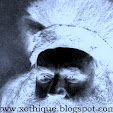This photo is overexposed, but then, damaged or obscured photography possesses interest in its own right. The reverse-toned quality of this apparent seaside shot gives it a nightmare feel almost like the negative sequences in F.W. Murnau's Nosferatu. The postcard is strikingly enigmatic, providing only a few clews as to its origin. The women to me have a Baltic, Eastern European, or Russian appearance (the man may also have this look). My understanding of the stamp box on the back is that it dates from the early 20th century, and then there's the seemingly incongruous inscription reading "Miss Jennie May Thornton" (certainly not a "East European" name). Was she somehow associated with the three people here, was she at the scene, or was she even one of the women in the photo? (Couldn't find her for certain on the googles, just one or two people who may be her.) One of the ironies of Turing Machines (aka "confusors"), dumb phones, and related instruments is that they foster a good deal of standardization and uniformity -- yet the World Wide Nets also allows one to post items such as this, which may be unique, or else quite rare.
About Me

- Jonathan
- Adalbert is a forum for me, to post ephemera, photography, poetry, occasional travel notes, and various spontaneous motions. Cover photo: Parsonage where my great-grandfather spent his early years. Taken near Liegnitz, Silesia, ca. 1870. The "xothique" portion of the web address is a nod to Clark Ashton Smith's fictional continent of Zothique.
Thursday, August 9, 2012
Sister Ray
This photo is overexposed, but then, damaged or obscured photography possesses interest in its own right. The reverse-toned quality of this apparent seaside shot gives it a nightmare feel almost like the negative sequences in F.W. Murnau's Nosferatu. The postcard is strikingly enigmatic, providing only a few clews as to its origin. The women to me have a Baltic, Eastern European, or Russian appearance (the man may also have this look). My understanding of the stamp box on the back is that it dates from the early 20th century, and then there's the seemingly incongruous inscription reading "Miss Jennie May Thornton" (certainly not a "East European" name). Was she somehow associated with the three people here, was she at the scene, or was she even one of the women in the photo? (Couldn't find her for certain on the googles, just one or two people who may be her.) One of the ironies of Turing Machines (aka "confusors"), dumb phones, and related instruments is that they foster a good deal of standardization and uniformity -- yet the World Wide Nets also allows one to post items such as this, which may be unique, or else quite rare.
Subscribe to:
Post Comments (Atom)


They don't look extremely Eastern European to me. Skates (or rays, I don't know much about fish) can apparently be found everywhere, for instance near the coast of Northern Scotland. I wonder what AazoA stands for (is it a secret code?).
ReplyDeleteThanks Rob, yes, the photo could have been taken many different places.
ReplyDeleteI just looked up the "AZO" imprint and it turns out to refer to a type of paper produced by Kodak.
The four triangles pointing up in the stamp box date this print from between 1904-1918.
How funny that you should mention the negative sequence of Murnau's Nosferatu. I always thought that was a stroke of genius - and to be able to create such terrific effects with so little technology.
ReplyDeleteThanks for the comment, Christine. I like Herzog's remake of Nosferatu as well!
ReplyDelete